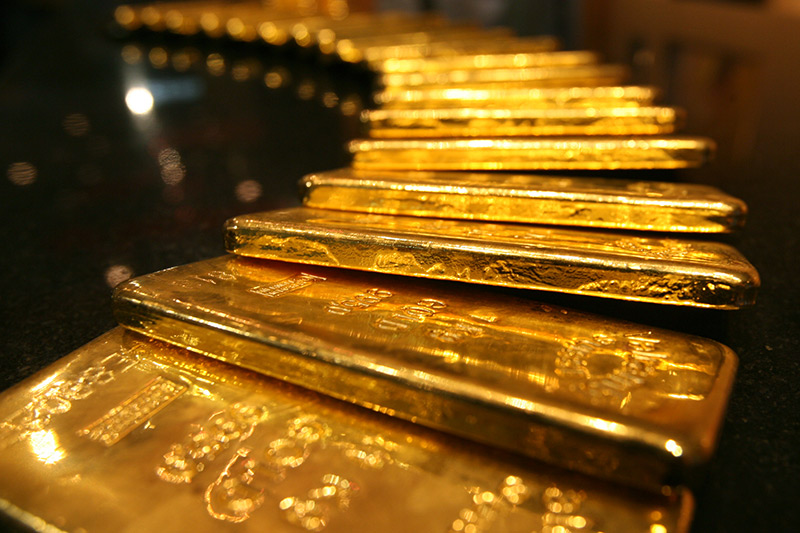Investing.com - Gold futures were under pressure on Monday, trading close to the previous session’s two-week low amid growing speculation over an earlier-than-expected end to the Federal Reserve’s quantitative easing program.
Moves in the gold price this year have largely tracked shifting expectations as to whether the U.S. central bank would end its bond-buying program sooner-than-expected.
On the Comex division of the New York Mercantile Exchange, gold futures for June delivery traded at USD1,434.25 a troy ounce during European morning hours, down 0.8% on the day.
Comex gold prices fell by as much as 1.4% earlier in the session to hit a daily low of USD1,424.95 a troy ounce. On Friday, gold futures fell to USD1,418.65 a troy ounce, the weakest level since April 24.
Gold prices were likely to find support at USD1,418.65 a troy ounce, Friday’s low and near-term resistance at USD1,469.45, the high from May 7.
Gold prices struggled due to a broadly stronger U.S. dollar, as dollar-priced commodities become more expensive to investors holding other currencies when the greenback gains.
The dollar index, which tracks the performance of the greenback against a basket of six other major currencies, rose 0.1% to hit 83.22.
The dollar was boosted amid growing expectations the Fed will wind down its stimulus program, amid indications of an improving U.S. economic outlook.
The Fed is currently running a USD85 billion monthly asset-purchasing program, which weakens the greenback to spur recovery.
Data on Thursday showed that showed that U.S. initial jobless claims fell to the lowest level since January 2008 in the week ending May 4.
Earlier this month official data showed that the U.S. economy added more jobs than forecast in April, pushing the unemployment rate to a more than four-year low of 7.5%.
Gold traders looked ahead to the release of U.S. data on retail sales later in the trading day to further gauge the strength of the economic recovery.
Any improvement in the U.S. economy could scale back expectations for further easing from the Federal Reserve.
Elsewhere on the Comex, silver for July delivery fell 0.45% to trade at USD23.55 a troy ounce, while copper for July delivery added 0.4% to trade at USD3.366 a pound.
Copper’s gains were limited after official data showed that industrial production in China rose at a slower rate than expected last month.
Official data released earlier showed that industrial production in China rose 9.3% in April, below expectations for a 9.5% increase and following an 8.9% rise the previous month.
Separate data showed that retail sales in China increased by 12.8% in April, in line with expectations.
The Asian nation is the world’s largest copper consumer, accounting for almost 40% of world consumption last year.
Moves in the gold price this year have largely tracked shifting expectations as to whether the U.S. central bank would end its bond-buying program sooner-than-expected.
On the Comex division of the New York Mercantile Exchange, gold futures for June delivery traded at USD1,434.25 a troy ounce during European morning hours, down 0.8% on the day.
Comex gold prices fell by as much as 1.4% earlier in the session to hit a daily low of USD1,424.95 a troy ounce. On Friday, gold futures fell to USD1,418.65 a troy ounce, the weakest level since April 24.
Gold prices were likely to find support at USD1,418.65 a troy ounce, Friday’s low and near-term resistance at USD1,469.45, the high from May 7.
Gold prices struggled due to a broadly stronger U.S. dollar, as dollar-priced commodities become more expensive to investors holding other currencies when the greenback gains.
The dollar index, which tracks the performance of the greenback against a basket of six other major currencies, rose 0.1% to hit 83.22.
The dollar was boosted amid growing expectations the Fed will wind down its stimulus program, amid indications of an improving U.S. economic outlook.
The Fed is currently running a USD85 billion monthly asset-purchasing program, which weakens the greenback to spur recovery.
Data on Thursday showed that showed that U.S. initial jobless claims fell to the lowest level since January 2008 in the week ending May 4.
Earlier this month official data showed that the U.S. economy added more jobs than forecast in April, pushing the unemployment rate to a more than four-year low of 7.5%.
Gold traders looked ahead to the release of U.S. data on retail sales later in the trading day to further gauge the strength of the economic recovery.
Any improvement in the U.S. economy could scale back expectations for further easing from the Federal Reserve.
Elsewhere on the Comex, silver for July delivery fell 0.45% to trade at USD23.55 a troy ounce, while copper for July delivery added 0.4% to trade at USD3.366 a pound.
Copper’s gains were limited after official data showed that industrial production in China rose at a slower rate than expected last month.
Official data released earlier showed that industrial production in China rose 9.3% in April, below expectations for a 9.5% increase and following an 8.9% rise the previous month.
Separate data showed that retail sales in China increased by 12.8% in April, in line with expectations.
The Asian nation is the world’s largest copper consumer, accounting for almost 40% of world consumption last year.
